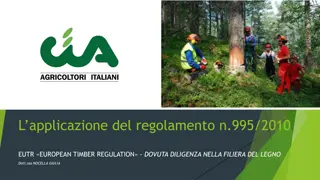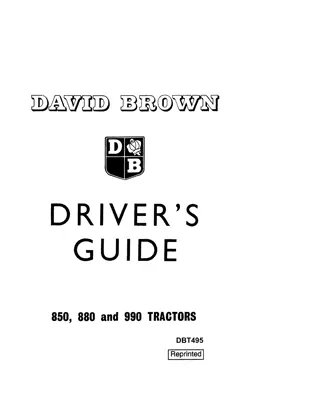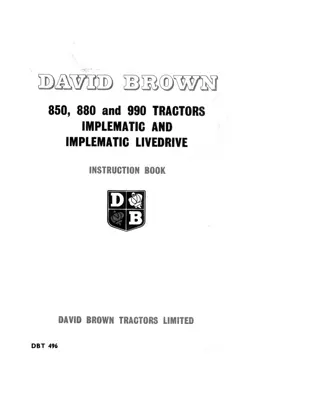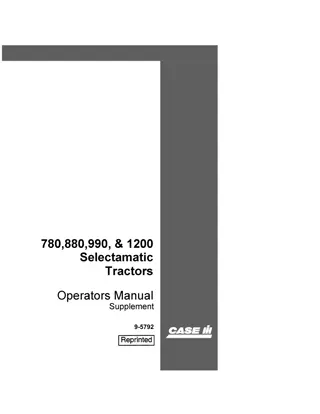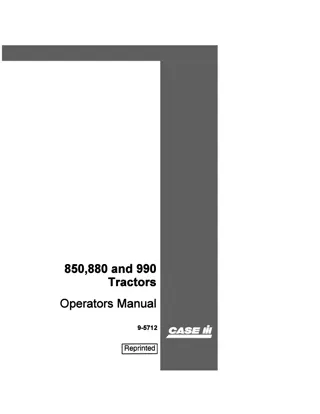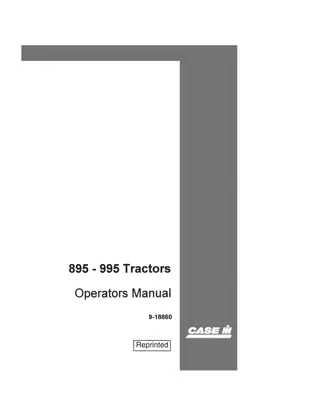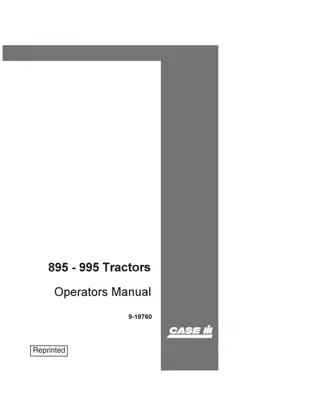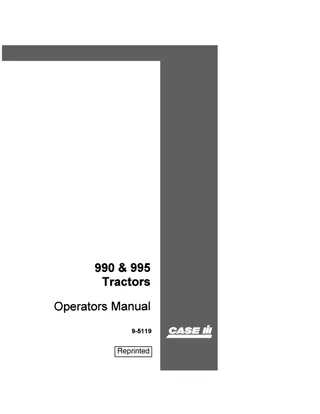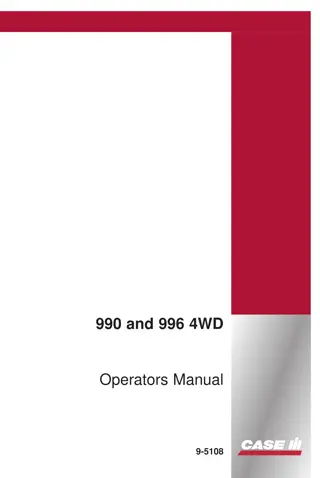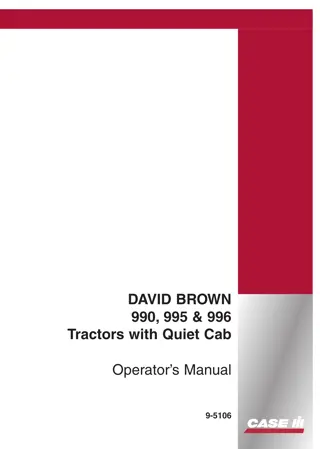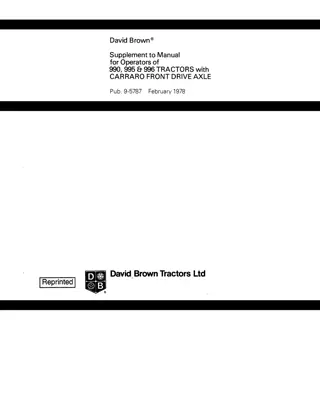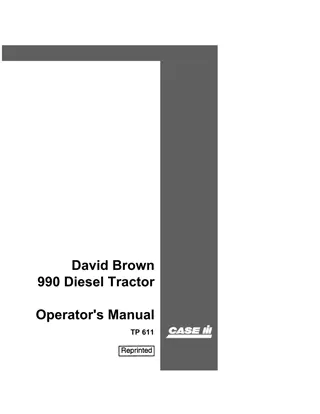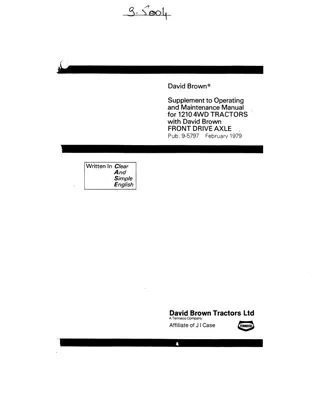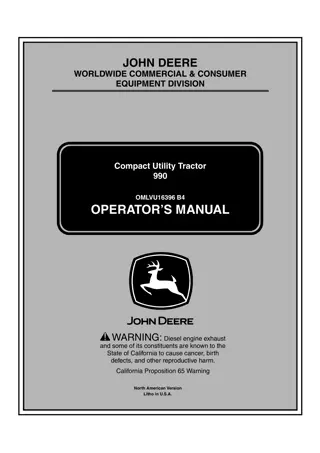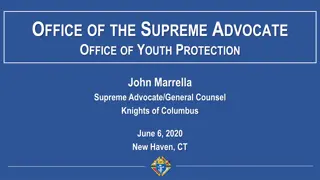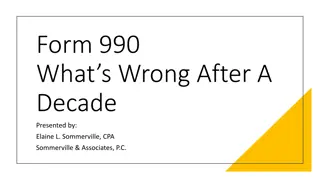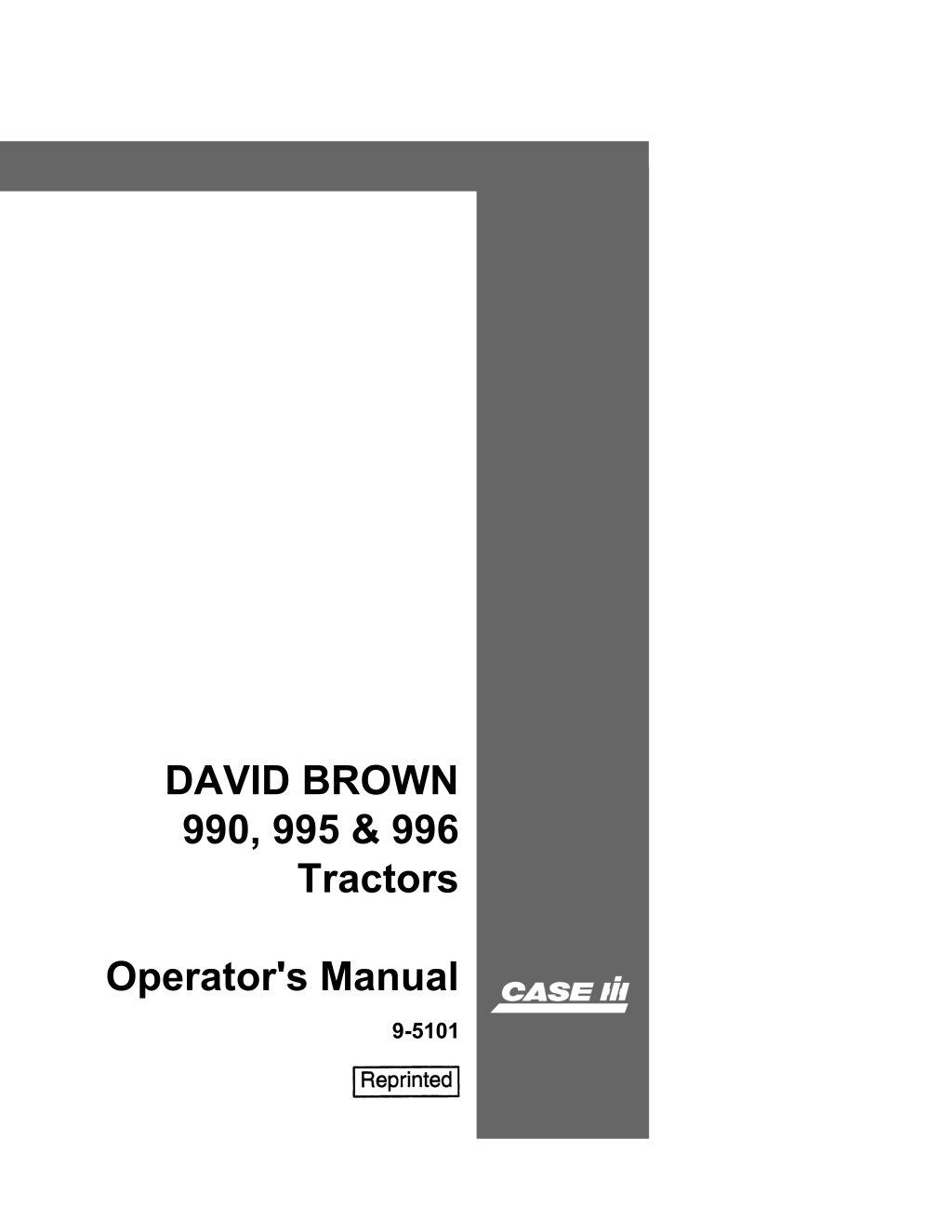
Case IH David Brown 990 995 & 996 Tractors Operator’s Manual Instant Download (Publication No.9-5101)
Please open the website below to get the complete manualnn//
Download Presentation

Please find below an Image/Link to download the presentation.
The content on the website is provided AS IS for your information and personal use only. It may not be sold, licensed, or shared on other websites without obtaining consent from the author. Download presentation by click this link. If you encounter any issues during the download, it is possible that the publisher has removed the file from their server.
E N D
Presentation Transcript
DAVID BROWN 990, 995 & 996 Tractors Operator's Manual 9-5101
6 THIS SAFETY ALERT SYMBOL INDICATES IMPORTANT SAFETY MESSAGES IN THIS MANUAL. WHEN YOU SEE THIS SYMBOL, , CAREFULL Y READ THE MESSAGE THAT FOLLOWS AND BE ALERT TO THE POSSIBILITY OF PERSONAL INJURY OR DEA TH. M171B If Safety Decals on this machine use the words Danger, Warning or Caution, which are defined as follows: DANGER: Indicates an immediate hazardous situation which if not avoided, will result in death or serious injury. The color associated with Danger is RED. WARNING: Indicates an potentially hazardous situation which if not avoided, will result in serious injury. The color associated with Warning is ORANGE. CAUTION: Indicates an potentially hazardous situation which if not avoided, may result in minor or moderate injury. It may also be used to alert against unsafe practices. The color associated with Caution is YELLOW. If Safety Decals on this machine are ISO two panel Pictorial, decals are defined as follows: The first panel indicates the nature of the hazard. The second panel indicates the appropriate avoidance of the hazard. Background color is YELLOW.IC'\ 6 WARNING IMPROPER OPERATION OF THIS MACHINE CAN CAUSE INJURY OR DEATH. BEFORE USING THIS MACHINE, MAKE CERTAIN THAT EVERY OPERATOR: Prohibition symbols such as \y X and 8 if used, are RED. Is instructed in safe and proper use of the machine. Reads and understands the Manual(s) pertaining to the machine. Reads and understands ALL Safety Decals on the machine. Clears the area of other persons. Learns and practices safe use of machine controls in a safe, clear area before operating this machine on a job site. It is your responsibility to observe pertinent laws and regulations and follow Case Corporation instructions on machine operation and maintenance. Bur 0-00000 2001 Case Corporation March, 1995 (Revised October, 1997) CASE and IH are registered trade marks of Case Corporation
DAVID BROWN 990, 995 & 996 Tractors Instruction Book
https://www.ebooklibonline.com Hello dear friend! Thank you very much for reading. Enter the link into your browser. The full manual is available for immediate download. https://www.ebooklibonline.com
A WARNINGI Improper operation of this machine may result in injury or death. Before operating this machine study the SAFETY POINTS starting on pagEt 2 and read this book thoroughly. A Look for this symbol which points out important safety precautions. It means ATTENTION! BECOME ALERTI YOUR SAFETY IS INVOLVED I David Brown policy is one of continuous d e v e l o p ~ ment and improvement and themfore the s p e c i f i c a ~ tion details may have been altered since this book went to press. Moreover, as the David Brown tractor is offered in a variety of forms to cover a large number of markets and applications, this handbook may contain details of items not applicable to the particular tractor for which it has been supplied,
DAVID BROWN Instruction Book 990, 995 and 996 Tractors David Brown Tractors Limited Meltham Huddersfield . England HD7 3AR , Publication 9 6101 December 1913
SAFETY POINTS Always lock the two foot brake pedals together when running on the highway. Always ensure the PTO is set to low ratio for implements designed to run at 540 rev/min. Running them faster may cause a dangerous mechanical failure. Always ensure the PTO (and Belt Pulley when fitted) is adequately guarded. Always remove loose clothing when working near moving parts of the tractor, engine and implements, or ensure that it is adequately fastened or tied up. Always remove the ignition/starter key from the tractor when leaving it unattended, especially where children have access. Always operate the steering and driving controls with care, for example:- Don't swerve or turn sharply at speed, Don't let the clutch in suddenly going up hill or the tractor may rear up. Don't brake fiercely, especially going backwards down hill. Always take extra care on steeply sloping ground. Move cautiously, as the sudden swing of a heavy implement, or pull of a trailer, may cause trouble. Always make sure before turning that there is room for any mounted implement which will swing outwards at the rear. Always hitch trailers to the approved drawbar or pick*up hitch which is below the centre line of the rear axle, Do not hitch above the centre line, 2
IMPORTANT DONT'S Do Not carry passengers 011 the linkages or on the tractor, except in an approved passenger seat Do Not dri!! into the safety frame. NOTE: Any damaged parts should be replaced immediately with new parts, Bent parts should not be straightened but replaced and no welding should be attempted on the safety frame. Bolts when replaced, must be of the correct tensile strength. After any accident to a safety frame it is advisable to report this to your local safety officer. Do Not lift the tractor by the cab lifting hooks. These are designed only for removing a cab from the tracto., Do Not tow the tractor at speed whore power steering is fitted, as there will be no oil pressure from the power steering pump and the steering will be heavy to operate. 3
INTRODUCTION Even the most experienced tractor user should read Sections 1, 2. 3 and 4 before commencing operations with his new tractor, A great deal of care goes into the building of every David Brown tractor, The engine is part run-In, the completed tractor is road tested and at each stage of assembly it is checked by a team of Quality Control Inspectors. The USef can help to maintain this in-built quality by carrying out the simple tasks outlined in the Regular Maintenance chapter - eventually to major repairs which are expensive as well as time wasting, Section 4, Neglect can lead Most difficulties afe experienced through incorrect methods of operation. Sections 1, 2 and 3 detail the easiest. quickest and most efficien of operating the tractor, especially the many design features h are special to the David Brown Tractor. Coupled with the above is the question of safety. A tractor can be a dangerous machine if handled without due caution and know- ledge gained beforehand from this book can prevent accidents. Three models of tractor are covered in this book, the 990, 995 and the 996 (which is known in some countries as the 995 with in- dependent PTO),* The main differences between these models is that the 995 and 996 have a longer stroke and higher powered engine than the 990, and the 996 has fully independent PTO controlled by a separate hand lever All three incorporate the Selectamatic Hydraulic system, first introduced by David Brown in 1965, and which has proved exceptionally reliable and simple to operate, Small refinements since then have further improved the system. The two versions of the David Brown 4-cylinder diesel engine used in these tractors are carefully matched to the transmission and maintain the David Brown reputation for low fuel consumption and ease of starting. "'NOTE: Those tractors fitted with independent PTO and stamped with serial numbers commencing 995/6/1/980001 afe referred to throughout this book as 996. This should be particu- larly noted in countries where the tractor is known as a "995 with independent PTO", (References to 995 in this book are confined to tractors stamped with serial numbers commencing 995/1/ 920001). 4
Tractor NumherJEngirlfl Numher When ordering parts or with any query always quote the full prefix and serial numbers as follows: Tractor letters and numbers as stamped on fight-hand edge of the chassis fmnt extension at A and on the identification plate, e,g. 990/1/850001. Engine Numbers as stamped on the flat vertical surface on the right-hand side ofthe cylinder block at B and on the identification plate, e.g. 449001/36588. Tractor Serial No. Engine Serial No ... Tractor Registration No. The final drive reduction ratio is stamped in the centre of the rear wheel hub. 5
CONTENTS Page 2 5 Safety Points " Serial Numbers Take Special Care of your New Tractor ,. First Service (50/100 hours) . , , . ., 10 10 SECTION 1 DESCRIPTION AND OPERATION - GENERAL " " 11 ., 11-14 INSTRUMENT PANEL 11 12 12 12 12 13 13 13 Engine Stop Control .. Engine Oil Warning Light " Charge Warning Light Transmission Filter Warning Light Direction Indicator . ' Hazard Warning Switch Light Switch " Engine Speed Indicator .. .. 15-20 LEVERS AN D PEDALS 15 15 17 19 Use of the Throttles ,. Brakes .. Clutch " Differentia I Lock " .. 21-23 SYNCHROMESH TRANSMISSION 21 22 Operation Gear Selection " 24 26 STARTING AND STOPPING ENGINE " 24 24 25 25 26 Starting the Engine .. Starting in cold weather Starting in extreme cold Stopping the Engine Stopping the Tractor 26 SEAT ADJUSTMENT
Page SECTION 2 DESCRIPTION AND OPERATION- SElECTAMATIC HYDRAULIC SYSTEM " Introduction , , Selector Dial Pointer Hand Lever , . Sensing Unit " Finger Guides" Lowering Control Dump Valve ,. Lift latch ,. Trailed Implements " ,. 27-44 27 28 28 29 29 29 29 30 31 32 34 OPERATING WITH DEPTH CONTROL .. OPERATING WITH DEPTH WHEEL (TCU) OPERATING EXTERNAL EQUIPMENT VIA THE 3-WAY VALVE 3-Way Valve .. Catch Unit OPERATING EXTERNAL EQUIPMENT WITH LIVE TAKE-OFF CONTROL VALVES OPERATING WITH HEIGHT CONTROL 36 36 40 41 43 SECTION 3 ~ ADJUSTMENTS AND SETTINGS .. 45-60 44 47 47 47 49 51 51 52 52 54 54 56 57 57 57 59 LINKAGE SETTINGS Stabilisers Slotted Lift Rods Drawbar Pick-up Hitch, , .. ,. WHEELS AND AXLES From Track Adjustment Rear Track Adjustment Track Settings for Ploughing Tyre Pressures Ballasting .. MULTI-SPEED POWER TAKE-OFF PTO DRIVEN IMPLEMENTS BELT PULLEY .. SELECTIVE SENSING UNIT HIGH CLEARANCE CONVERSION 7
Page 61-76 SECTION 4 - REGULAR MAINTENANCE 61 62 65 72 Introduction Table of Routine Service Tasks Lubrication Chart Fuel, Grease and Anti-freeze Specifications Approved Lubricants > > , > , , . . . . .. 73-76 .. 77-112 SECTION 5 - SERVICING INFORMATION 77 78 Introduction Removal of the Bonnet (hood) . . . . . . .. 79 92 ENGINE 79 80 82 82 84 85 86 87 89 89 90 90 91 92 Air Cleaner Cooling System Fan Belt Adjustment Fuel Storage .. Fuel Filter Elements ,. Sediment Bowl Injectors Venting the Fuel System Injection Pump and Governor Engine Lubricating Oil Oil Filter Element Oil Pump Wire Filter .. Valve Clearance Cylinder Head Tightening . . . . . . . , . , . . > .. 93-104 CHASSIS 93 93 94 95 95 98 101 102 103 103 104 lubrication Front Axle Front Hub Final Drive Reductions Transmission and Hydraulic System Hydrostatic Power Steering Brakes ., .. Clutch (not 996) Transmission Clutch (996 only) .. PTO Clutch (996 only) Belt Pulley Unit . , .. .. ., . <
Page ELECTRICAL ., 105*111 105 106 106 107 107 108 108 A l t ~ m a t o r Auxiliary Equipment <. Battery . Dynamo (Generator) .. Fuse Starter ., Wiring . . , . , SECTION ) - SPECIFICATION AND DATA 113-140 Diesel Engine .. Chassis.. Ughting Equipment (Bulbs) Travel Speed Tables -- 10/49 final drives Travel Speed Tables - Travel Speed Tables --- 9/50 final drives Accessories Implement and Equipment Manufacturers Abbreviations .. 113 119 126 128 131 134 137 138 140 .. . . . . 11/49 final drives . . . . 9
TAKE SPECIAL CARE OF YOUR NEW TRACTOR Although every engine is tested and run-in at the factory, care should be taken during the first 25 to 50 hours' use, Avoid excessive speeds or Im:lding, Do not allo unduly, instead change to a lower gear. U engine speeds from 1200 to 1800 rev Imin. Prolonged light load should also be avoided as this might lead to cylinder wall glazing with consequent high oil consumption, Best running-in is achieved by alternating between low/medium and high (not maximum) loading. ine to labour range of FIRST SERVICE (50/100 HOURS) The first service should be done by a David Brown dealer who will carry out a full check on the tractor, The main essentials in this service are ;- 1. Change the fuel filter element. 2. Change the engine oil and filter element, 3. The transmission gearbox should be flushed and the wire mesh and magnetic filter cleaned. A new paper filter element should be fitted and the gearbox refilled with new oil. 4, Change the oil in the final drive reduction housings. 5. Check the tightness of cylinder head bolts and clearances, and the tightness of main external nuts and bolts especiaHy rear wheel nuts. valve NOTE: To remove any contaminants which may build up in the oil due to initial bedding in, it is essential to drain the transmission oil and refill with new oil at the 50/100 hour service (see pages 73 to 76). 10
SECTION 1. DESCRIPTION AND OPERATION-GENERAL INSTRUMENT PANEL G H B I..: FIGURE 1/1. !NSTRUMENT PANEL A. Ignition - 8. Ligfiting switch C. Engine speed indicator (or speedometer) D. Charge warning light (red) E Engine of! warning light (green) sterter switch Transmission filter warning light (yellow) G. Weter temperature H. Hazard warning switch J. Fuel gauge Ie Direct/of} indicetof Bwitch L Hom push button M Engine stop control/choKe F. Engine stop control This cuts off the fuel supply to the injectors. Never stop the engine by letting the tank run dry. This allows air to enter the system and is very difficu It to Before starting the engine pul! out the stop control and lower into the retaining slot. To stop; lift the knob and allow it to move forward. rid of.
Engine oil warning Ught The green light is illuminated when oil pressure is too low. Ensure that it lights when the isolating switch is turned on and goes out when the engine runs. Charge warning light The red light is illuminated when the isolating switch is turned on but should extinguish as soon as the dynamo or alternator commences to charge. Transmission filter warning Ught When the fal! in pressure across the full flow filter element in the hydraulic system is high enough to open the filter by-pass valve and allow oil to by-pass the filter element, the yellow warning lamp illuminates. This may occur (a) when the filter element is blocked with dirt and requires changing for a new one or (b) when the oil is cold and engine speed is high. It is also arranged to light when the isolating switch is turned on and the driver should check that the bulb is intact each time before starting the engine. A faulty bulb should be replaced as soon as it fails. If the bulb glows or flickers at idling speeds, this should be ignored. The warning lamp may illuminate at less than full engine speeds when the oil is cold. The engine speed should be adjusted so that the light is not kept on for more than a few minutes otherwise proper filtering of the oil will not take place. As the filter element becomes blocked with dirt, the warning light will come on at progressively lower engine speeds so that, even when the oil is warm, full working speed may not be achieved without causing the bulb to light A When the bulb lights at 1800 rev/min after a warming up period .. of 30 minutes the full flow filter element must be changed for a new one at the first opportunity. Direction indicator switch Move the switch to the left to operate the l e f t ~ h a n d flashers and vice versa, Do not forget to return the switch to centr(} position after use. 12
Hazard warning switch (if fitted) When the switch is pulled out al! four flashers work together. This is useful when working on the highway at very slow speeds. Make sure it is switched off oofore proceeding normally on the road. light switch This has 4 positions: 1. Off 2. Side and tail 3. Side, tail and head (low beam) 4. Side, tai! and head (high beam) The rear plough lamp is controlled by its own switch, mounted on the lamp housing. The lamp can be switched on when the main light switch on the instrument panel is in any of the positions 2, :3 or 4. Engine speed indicator The engine speed indicator (rev counter} fitted to the instrument panel, shows the engine revolutions per minute and should be used in conjunction with the chart attached to the bonnet (hood) in order to determine the travel speed ofthe tractor (see Fig. 1/2) FIGURE 1/2. GEAR/SPEED CHART A. Blue line at SilO fev/min pro in low ratio B. Red line at 1000 fev/min pro in high ratio C. Red fine at SilO rev/min PTO in high fhtio Alternative charts ate available showing speeds in mile/h Of km/h and to suit different wheel slzos and final drive ratios. 13
The engine speed is marked along the bottom edge of the chart An imaginary vertica! line projected upwards will cross the various horizontal gear bands at the appropriate speed, The travel speed in any gear can, therefore, be obtained by first reading the engine speed indicator and transferring to the chart, Alternatively, any required travel speed in an appropriate gear can be projected downwards and the necessary engine speed determined. The throttle can then be set to give the required engine speed as observed on the engine speed indicator. Use of the chart for PTO work is facilitated by the provision of two red vertical lines corresponding to the high PTO ratio and a blue line for the low PTO ratio. Each line is marked immediately above the engine speed with the ratio (high or low) and the PTO speed (540 or 1000). Therefore, having decided which PTO speed and ratio is required for the lYpe of work in hand, it is only necessary to inspect the appropriate vertical coloured line and note which horizontal band bears the nearest desired travel speed and choose the gear ratio shown at the left-hand edge, The speed chart gives accurate speeds for the tyresfitted to the tractor when new. If it is desired to fit lYres of a different size, it Is only necessary to obtain a new chart from your dealer for fixing to the bonnet top. The belt pulley should be used at a PTO speed of 1000 rev/min, SF Fig. 1/2. 14
Suggest: If the above button click is invalid. Please download this document first, and then click the above link to download the complete manual. Thank you so much for reading
LEVERS AND PEDALS FIGURE 1/3, PEDALS Clutch pedal C. Locking bar [), Faat tlirottle A B. Brake pedals Use of throttles The rated speed of the engine is 1800 rev Imin giving a PTO speed of 540 rev/min in low ratio. This is a convenient and economical speed for normal farm work, but where necessary the engine may be operated under heavy loads at any speed between 1400 rev/min and its maximum governed speed, The speed may be set by observing the engine speed indicator C, Fig. 1/1, The foot throttle will be found particularly convenient for road work and for involving frequent gear changing, e,g. loader work. Foot throttle To obtain tl1efull range of engine speeds from the foot throttle, the hand throttle should be set to the idling position. Brakes Twin foot pedals at the right*hand side give independent control of the brakes to assist s t e ~ r i n g in confined spaces, However, to ensure full braking power on the road and at higher speeds, the locking bar, C, Fig. 1 should be used. 15
https://www.ebooklibonline.com Hello dear friend! Thank you very much for reading. Enter the link into your browser. The full manual is available for immediate download. https://www.ebooklibonline.com


